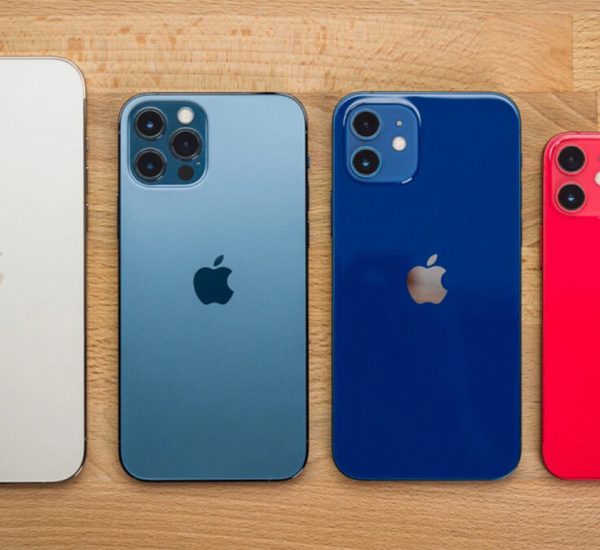The new iPhone 13 series from Apple
with LTE tariff from EUR 34.99 per month
We have been waiting eagerly for this: Apple finally presented the new iPhone 13 series with the keynote in September 2021. You can already pre-order the iPhone 13 mini, iPhone 13, iPhone 13 Pro and iPhone 13 Pro Max at yourfone. The chic smartphones from Apple are available in combination with an LTE tariff in our deal. The packages are now available to you from 34.99 EUR per month, from the 13th month for 39.99 EUR. The offer is limited to November 15, 2021. So it pays to be fast!
iPhone 13: Apple is sending a new range of smartphones into the race
Since 2007, a new year has always been called a new generation of iPhones. The models of the new iPhone 13 were presented in September 2021: Apple fans can look forward to updates on the display, chip, memory and smartphone camera. But what exactly can the new iPhones do and what makes them different from the previous models of the iPhone 12? We have looked at the technical data in detail and will tell you.
Everything you need to know: the iPhone 13 series at a glance
The models of the iPhone 13 series can be pre-ordered from September 17th, they will be delivered a week later for the official start of sales, more precisely on September 24th 2021.
The Apple 13 series includes the following iPhone models:
iPhone 13 mini
iPhone 13
iPhone 13 Pro
iPhone 13 Pro Max
The iPhone 13 mini is a 5-inch cell phone and is therefore particularly handy. Nevertheless, the mini version offers almost the same features as the iPhone 13, with the exception that the battery is a bit weaker. The Pro models impress again with a significantly better display and camera performance.
These are the innovations of the iPhone 13 generation:
Apple A15 bionic chip for even faster performance
Enlarged display area thanks to a narrower notch
New variety of colors: rose, midnight, polar star and sierra blue
Smoother operation and faster responsiveness with 120 Hertz displays on the iPhone 13 Pro models
More storage space for photos and videos: The models start at a size of 128 GB and offer a maximum of 1 TB of flash storage in the iPhone 13 Pro and Pro Max
Stronger batteries for a longer run time
Camera update with larger pixels and new photo and film techniques
New operating system: iOS 15
For those who have a little more reading time: the iPhone 13 series in detail
In the last few months there have been numerous rumors about the new iPhone generation on the Internet. We were therefore all the more curious to see which leaks have actually come true. Find out what the new iPhones look like and what they can do here.
Smaller notch, IP certification, wide range of colors
We did not expect a design revolution because we know from the past that Apple is not a fan of frivolous design revisions. And with this expectation in mind, we weren’t really surprised: the iPhone 13 looks similar to the iPhone 12, with only minor differences. However, there is an obvious change in the display. Apple has been working hard to make the notch even smaller since it was introduced on the iPhone X, thereby increasing the ratio between the front and the screen. Apple has now also succeeded in doing this with the iPhone 13: According to the manufacturer, the display recess has been reduced by 20 percent and is also visibly narrower than before. Some will surely also recognize that the notch has become slightly wider for this. But that is manageable because it is only a few millimeters. Another visible difference compared to the iPhone 12 can be seen on the back of the device: The camera lenses on the 13 model are no longer arranged one below the other, but diagonally to one another.
While the mini and standard models of the iPhone 13 are in an angular, shiny aluminum frame, the Pro versions are made of high-quality stainless steel and have a matt finish. Robust glass, also known as “ceramic shield”, is used again as a screen protector. Similar to the previous series, the iPhone 13 models are certified with protection class IP68 and are therefore waterproof cell phones. Apple also remains true to its extensive color palette: the iPhone 13 and iPhone 13 mini are available in pink (“Rosé”), blue, black (“Midnight”), white (“Polarstern”) and in (Product) Red. The colors silver, graphite, gold and blue (“Sierra blue”) are available for the Pro versions.
The displays at a glance:
The display sizes and resolutions remain unchanged compared to the previous models. While the iPhone 13 mini fits in every handbag and trouser pocket and can still be operated with one hand, the iPhone 13 Pro Max is ideal for mobile work. The standard and Pro versions of the iPhone 13 are versatile with a screen diagonal of 6.1 inches.
iPhone 13 mini: 5.4 inches, 2,340 x 1,080 pixels (476 ppi)
iPhone 13: 6.1 inches, 2,532 x 1,170 pixels (460 ppi)
iPhone 13 Pro: 6.1 inches, 2,532 x 1,170 pixels (460 ppi)
iPhone 13 Pro Max: 6.7 inches, 2,778 x 1,284 pixels (458 ppi)
New OLED display and higher refresh rate for the Pro models
Apple is installing a new Super Retina XDR display with OLED technology that is said to be 28 percent brighter than the screen of its predecessor. Thus, the screen achieves a maximum brightness of 800 nits (mini, standard) or 1,000 nits (Pro models) and with HDR content a peak brightness of up to 1,200 nits. The extended P3 color space is also supported. High-resolution image content in vivid colors and strong contrasts is therefore out of the question.
When the iPhone 12 series was unveiled last year, the refresh rate was hotly debated. The 120 Hertz, which is now common in the industry for premium smartphones, which definitely include the iPhone, fans had already hoped for in the iPhone 12. Apple surprisingly stayed true to the somewhat old-fashioned 60 Hertz. The big upgrade to a turbo display was therefore eagerly awaited for the iPhone 13. But the higher refresh rate of up to 120 Hertz can only be found in the Pro models, the iPhone 13 and iPhone 13 mini still run at the conventional 60 Hertz. Apple uses a dynamic frequency between 10 and 120 Hertz for the Pro models, so that ultra-fluid display is possible even with graphics-intensive mobile games, but at the same time the cell phone battery is saved. Apple calls the technology “ProMotion”: The frequency is simply automatically adapted to the respective application. So far, the technology was reserved for the Apple iPad Pro 2021 models.
The displays at a glance New OLED display and higher refresh rate for the Pro models
Apple’s A15 bionic chip is twice as fast as the competition
The A15 Bionic chip logically follows as the cell phone processor in the iPhone 13 after the A14 SoC in the models of the iPhone 12 series. Like the A14, the successor was also manufactured using the five-nanometer process and has six CPU cores and four GPU cores. The 5 nm process corresponds to the current industry standard and is also used in upper-class chips such as the Qualcomm Snapdragon 888, which is used in numerous Android phones such as the Xiaomi Mi 11 and ASUS ROG Phone 5. Apple itself emphasizes the lead of the new chip over Android smartphones: the CPU and graphics engine are 50 percent and 30 percent faster and the performance is even more energy-efficient. Apple also uses artificial intelligence (AI) for better performance.
More battery power, improved 5G, iOS 15 and more storage
Apple is usually reluctant to give precise details on battery capacity. No specific information on the battery was disclosed for the iPhone 13 series either. What is certain, however, is that Apple promises more power for all models. The iPhone 13 phones are equipped with a larger cell phone battery that, according to Apple, should last noticeably longer than its predecessor. For the iPhone 13 mini and iPhone 13 this means approx. 1.5 hours longer, while the Pro models have a longer battery life of around 2.5 hours. Inductive charging via MagSafe is also on board again.
Of course, the new iPhones are also 5G cell phones again. In addition, Apple has modernized 5G technology so that it encompasses even more frequencies and higher speeds are possible. The iPhone 13 models are of course delivered with Apple’s new iOS 15 operating system. The software is now also available as an update for older Apple phones from the iPhone 6S and offers numerous optimizations and features with regard to Facetime and Siri.
The iPhone 12 was available with 64, 128, 256 and 512 GB of internal memory, which, as usual with Apple smartphones, cannot be expanded via microSD. With the iPhone 13, the maximum for the Pro models has been increased to a whopping 1 terabyte, which is almost double the previous upper limit. In addition, there is no longer a 64 GB storage option for the iPhone 13 models, instead the 13 series starts with 128 GB of flash storage.



